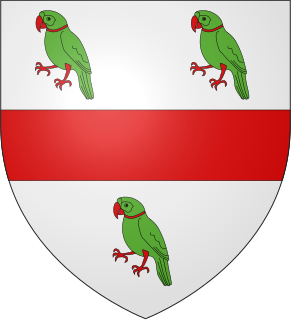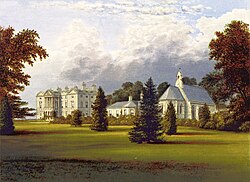
Roche Abbey is a now-ruined abbey in the civil parish of Maltby, Rotherham, South Yorkshire, England. It is in the valley of Maltby Dyke, known locally as Maltby Beck, and is administered by English Heritage. It is a scheduled monument and Grade II* listed in the National Register of Historic Parks and Gardens.

Earl of Scarbrough is a title in the Peerage of England. It was created in 1690 for Richard Lumley, 2nd Viscount Lumley. He is best remembered as one of the Immortal Seven who invited William of Orange to invade England and depose his father-in-law James II. Lumley had already been created Baron Lumley, of Lumley Castle in the County of Durham, in 1681, and Viscount Lumley, of Lumley Castle in the County of Durham, in 1689. These titles are also in the Peerage of England. The title of Viscount Lumley, of Waterford, was created in the Peerage of Ireland in 1628 for his grandfather Sir Richard Lumley, who later fought as a Royalist in the Civil War.

Baron Savile, of Rufford in the County of Nottingham, is a title in the Peerage of the United Kingdom. It was created in 1888 for the diplomat Sir John Savile. He was the eldest of the five illegitimate children of John Lumley-Savile, 8th Earl of Scarbrough, and the grandson of John Lumley-Savile, 7th Earl of Scarbrough. The latter was the fourth of the seven sons of Richard Lumley-Saunderson, 4th Earl of Scarbrough, and his wife Barbara, sister and heiress of the politician Sir George Savile, 8th and last Baronet, of Thornhill, who bequeathed the substantial Savile estates in Yorkshire and Nottinghamshire to his nephew the Hon. Richard Lumley-Saunderson, later 6th Earl of Scarbrough. On his death the estates passed to his younger brother, the aforementioned seventh Earl, and then to his son the eighth Earl. The latter bequeathed the estates to his second natural son Captain Henry Lumley-Savile. When he died they passed to his younger brother Augustus William Lumley-Savile (1829–1887) and then to his eldest brother, the aforementioned John Savile, who was created Baron Savile the following year.

Maltby is a former mining town and civil parish of 16,688 inhabitants (2011) in the Metropolitan Borough of Rotherham, South Yorkshire, England. It was historically in the West Riding of Yorkshire. It is located about 6 miles (10 km) east of Rotherham town centre and 10 miles (16 km) north-east of Sheffield city centre. It forms a continuous urban area with Hellaby, separated from the rest of Rotherham by the M18 motorway.

The title Marquess of Halifax was created in the Peerage of England in 1682 for the George Savile, 1st Earl of Halifax.
Kimberworth is a suburb of Rotherham, South Yorkshire, England. It is located in the Metropolitan Borough of Rotherham, about 2.2 miles (3.5 km) north-west of Rotherham town centre and 4.7 miles (7.6 km) north-east of the City of Sheffield.

The title Earl Castleton, of Sandbeck in the County of York, was created in the Peerage of Great Britain in 1720 for the 6th Viscount Castleton, who had previously been created Baron Saunderson, of Saxby in the County of Lincoln, in 1714, and Viscount Castleton, of Sandbeck in the County of York, in 1716, both also in the Peerage of Great Britain.
Saunderson is a surname. It may refer to:

Rufford Abbey is a country estate in Nottinghamshire, England, two miles (4 km) south of Ollerton. Originally a Cistercian abbey, it was converted to a country house in the 16th century after the Dissolution of the Monasteries. Part of the house was demolished in the 20th century, but the remains, standing in 150 acres of park and woodland, are open to the public as Rufford Country Park. Part of the park is a local nature reserve.
Richard Aldred Lumley, 12th Earl of Scarbrough, styled Viscount Lumley between 1945 and 1969, was an English nobleman.
James Saunderson, 1st Earl Castleton was an English landowner and Whig politician who sat in the English and British House of Commons between 1698 and 1710.
Thomas Lumley-Saunderson, 3rd Earl of Scarbrough, KB was a British peer, British Army officer and diplomat.

William Levett was lord of the manor of the South Yorkshire village of Hooton Levitt, a village named in part for his ancestors, and became the owner of the patronage of Roche Abbey on marriage to the granddaughter of the Abbey's cofounder Richard FitzTurgis, a Norman baron who co-founded Roche with the great-nephew of one of England's most powerful Norman barons, Roger de Busli.
George Augustus Lumley-Saunderson, 5th Earl of Scarbrough, styled Viscount Lumley until 1782, was a British peer and politician who sat in the House of Commons from 1774 to 1780.
Richard Lumley-Saunderson, 4th Earl of Scarbrough PC was a British peer, styled Viscount Lumley from 1740 to 1752.

Richard Osbert Lumley, 13th Earl of Scarbrough, known as Viscount Lumley until 2004, is a British peer and landowner.

Lieutenant-Colonel Richard George Lumley, 9th Earl of Scarbrough was an Anglo-Irish peer and soldier.

Oldcotes Dyke is the name of the final section of a river system that drains parts of north Nottinghamshire and the Metropolitan Borough of Rotherham in South Yorkshire, England. Historically, it has supported milling, with seven water mills drawing their power from its water, and ran through the grounds of the Cistercian Roche Abbey. It is a tributary of the River Ryton.

Stone is a hamlet in the civil parish of Maltby, in the Rotherham district lying to the south of Rotherham, South Yorkshire, England. Roche Abbey stands to the west of the hamlet, with Sandbeck Park to the north.
Maltby is a civil parish in the Metropolitan Borough of Rotherham, South Yorkshire, England. The parish contains 40 listed buildings that are recorded in the National Heritage List for England. Of these, one is listed at Grade I, the highest of the three grades, three are at Grade II*, the middle grade, and the others are at Grade II, the lowest grade. The parish contains the town of Maltby and a large area to the southeast of the town. This area includes the country house of Sandbeck Park, which is listed together with a number of associated buildings and structures. Also in the area is Roche Abbey, and items in its grounds are listed. The other listed buildings include houses and cottages, a church and a tomb in the churchyard, a market cross, former watermills, farmhouses and farm buildings, mileposts, and a war memorial.















